It looks like you're using an Ad Blocker.
Please white-list or disable AboveTopSecret.com in your ad-blocking tool.
Thank you.
Some features of ATS will be disabled while you continue to use an ad-blocker.
share:
Archaeologists in Jordan have taken high-resolution aerial photographs of 11 of what they refer to simply as "Big Circles" — mysterious stone wall
circles with unknown origin purpose and origin. There are at least a dozen of these circles in Jordan and another in Syria, nearly vanished, that was
discovered in 2013. The circles, which are estimated to be at least 2,000 years old and possibly even prehistoric, were first spotted by aircraft in
the 1920's. One of the most curious features of the giant circles (average size is about 1,300 feet) is the lack of entrances.
From Live Science (all images: Professor David L. Kennedy, APAAME):
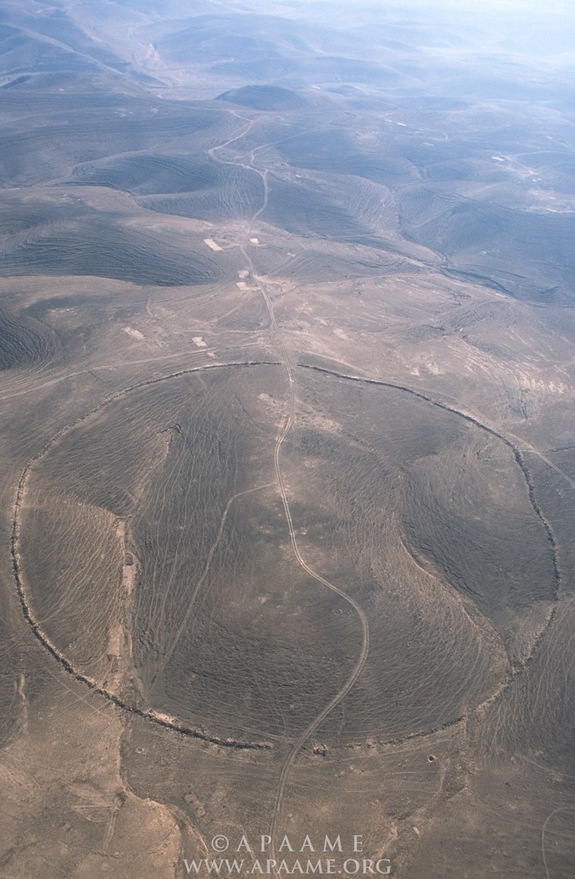 Circle J2 - 390 m (1,280 feet) in diameter.
Circle J2 - 390 m (1,280 feet) in diameter.
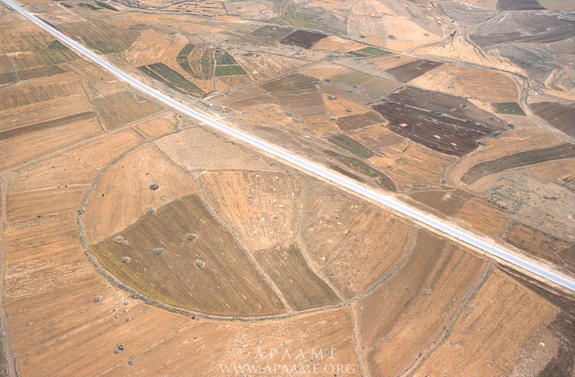 Circle J3 - 400 m (1,312 feet) in diameter.
Circle J3 - 400 m (1,312 feet) in diameter.
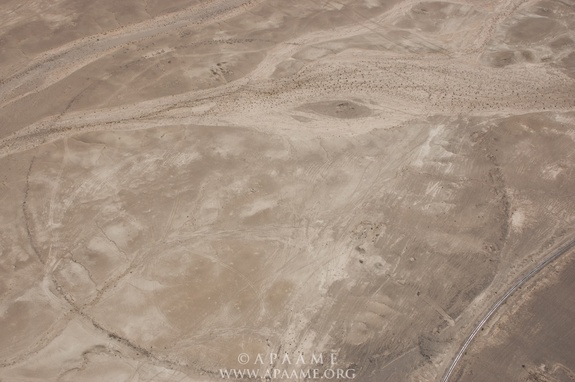 Circle J4 - 420 m (1,378 feet) in diameter.
Circle J4 - 420 m (1,378 feet) in diameter.
Another of the circles has a Roman road running through it, indicating that the construction of the "Big Circles" is at least pre-Roman. Much more ground work is needed but a few of the circles have been visited by archaeologists. Here's what they look like from the ground:
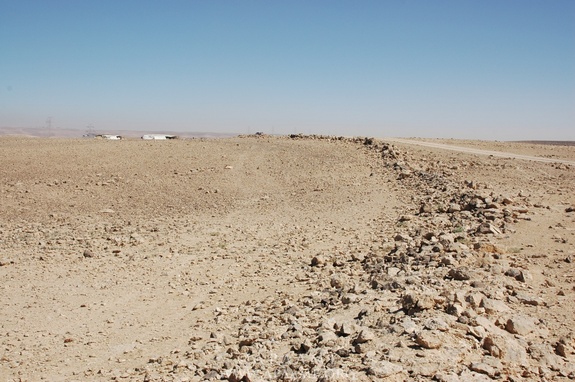 Circle J2 as seen from the ground.
Circle J2 as seen from the ground.
 Circle J3 with pit exposing layers of wall.
Circle J3 with pit exposing layers of wall.
From the related Live Science article:
The opinion of researchers studying the circles, Professor Kennedy included, is that they were unlikely to be used as corrals due to the precision of their circular shape, the low height of the walls and of course, the lack of entrances.
From Live Science (all images: Professor David L. Kennedy, APAAME):



The Big Circle called J4 is about 420 m (1,378 feet) in diameter. An ancient track road runs through it. South of the circle this track road has three Roman milestones. During the Roman Empire milestones were erected at regular intervals, giving travelers an idea of how far they'd gone. Milestones also bore the name of the Roman emperor, letting people know that Rome controlled the territory.
Another of the circles has a Roman road running through it, indicating that the construction of the "Big Circles" is at least pre-Roman. Much more ground work is needed but a few of the circles have been visited by archaeologists. Here's what they look like from the ground:


From the related Live Science article:
The circles would not have been hard to build, Kennedy said. They were constructed mainly with local rocks, and a dozen people working hard could potentially complete a Big Circle in a week, Kennedy told Live Science in an email.
However, building the circles in a precise shape would have taken some planning. "In the case of those circles that [are] near-precise circles, it would have required at least one person as 'architect,'" Kennedy said, adding that this architect could simply have tied a long rope to a post and walked in a circle, marking the ground as he or she moved around. "That would also explain the glitches [in the circles] where the land was uneven," as the architect wouldn't have been able to keep walking in a perfect circle at those spots.
The opinion of researchers studying the circles, Professor Kennedy included, is that they were unlikely to be used as corrals due to the precision of their circular shape, the low height of the walls and of course, the lack of entrances.
edit on 2014-10-30 by theantediluvian because: (no
reason given)
We need to start building a giant corkscrew and pull out those pieces of land, we could fine a secret underground base, or a good wine, either way we
win
This is incredibly fascinating, you have to ask yourself, why would they go through so much work...was it a way of splitting up land for farming? maybe there was a "fence"of some kind to keep animals in one place?
or maybe a way for mankind to communicate with the unknown, a plea to a cold, vast universe, that we are here, and deep down, all wish to know who or what is out there, or if we are in fact, alone.
This is incredibly fascinating, you have to ask yourself, why would they go through so much work...was it a way of splitting up land for farming? maybe there was a "fence"of some kind to keep animals in one place?
or maybe a way for mankind to communicate with the unknown, a plea to a cold, vast universe, that we are here, and deep down, all wish to know who or what is out there, or if we are in fact, alone.
a reply to: theantediluvian
Very interesting indeed: some thought, marked arena for cavalry training or mock/full scale combat. Marking of territory for a burial or special camp site. Unknown religious or magical ritual or the actions of a madman.
The circles aren't precise and cover uneven ground, hmmmm
Very interesting indeed: some thought, marked arena for cavalry training or mock/full scale combat. Marking of territory for a burial or special camp site. Unknown religious or magical ritual or the actions of a madman.
The circles aren't precise and cover uneven ground, hmmmm
I would be interested if there is any trace of wood. The Zulu built similar complexes, small foundations then pickets, outside thorn bushes...etc.
for defense of a village. Openings were hidden. They appear to be an early version of a fort to me.
Just my 2 cents
MG
Just my 2 cents
MG
a reply to: Hanslune
All but one of the circles is fairly precise in terms of its geometry (though some do cover uneven ground). One of the articles mentions three cairns at one of the circles but they believe them to be a later addition and not related to the circle's construction. I'd say the next step is to fully excavate the interior of one. If they were used to encircle camps for instance, there would be the remains of the fires.
All but one of the circles is fairly precise in terms of its geometry (though some do cover uneven ground). One of the articles mentions three cairns at one of the circles but they believe them to be a later addition and not related to the circle's construction. I'd say the next step is to fully excavate the interior of one. If they were used to encircle camps for instance, there would be the remains of the fires.
edit on 2014-10-30 by
theantediluvian because: (no reason given)
Some people long ago had a little too much time on their hands. Someone had an idea to build this thing and talked others into helping. It's funny
how little people have changed over the last two thousand years. Back then people didn't have to buy expensive technology to do this kind of stuff,
the ones getting rich now make equipment and technology.
An encamped army with hundreds could probably make one fast.
Lots of warring and traveling to wars in that area in the ancient past.
Lots of warring and traveling to wars in that area in the ancient past.
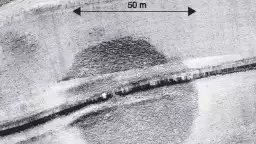
this picture taken under sea of galilee israel
i dont know what their pupose..but i think this structure very important to them..
nice science op..SNF
I see old dryed up riverbeds in all of them.
My guess would be a huge coral where they would keep domesticated cattle.
Or collect migrating herds by chasing them into the corral.
My guess would be a huge coral where they would keep domesticated cattle.
Or collect migrating herds by chasing them into the corral.
originally posted by: EartOccupant
I see old dryed up riverbeds in all of them.
My guess would be a huge coral where they would keep domesticated cattle.
Or collect migrating herds by chasing them into the corral.
They already know the walls were not high enough for this purpose.
originally posted by: rickymouse
Some people long ago had a little too much time on their hands. Someone had an idea to build this thing and talked others into helping. It's funny how little people have changed over the last two thousand years. Back then people didn't have to buy expensive technology to do this kind of stuff, the ones getting rich now make equipment and technology.
Well there are a lot of them as Cheesy shows some even under the sea and from the OP...
aerial photographs of 11 of what they refer to simply as "Big Circles
Making a living took everyones time then as it does now I doubt they made huge circles for no reason at all.
originally posted by: cheesy
this picture taken under sea of galilee israel
i dont know what their pupose..but i think this structure very important to them..
nice science op..SNF
Your picture makes shows the circle beyond just seeing the outline do you know what causes the color, I wonder if the circles originally did contain a depression which is since filed in.
Also I wonder are all of the circles the same approximate diameter? They mention 1,378, 1,312, 1,280 so a purpose which required a certain size.
edit on 30-10-2014 by Char-Lee because: (no reason given)
Maybe the land was once owned by a rancher with 1 leg shorter than the other
However, building the circles in a precise shape would have taken some planning. "In the case of those circles that [are] near-precise circles, it would have required at least one person as 'architect,'" Kennedy said,
Or a big piece of string tied to a pole..
edit on 30-10-2014 by Soloprotocol because: (no reason given)
a reply to: Soloprotocol
Yep, that's definitely how I'd do it! I suspect there's a bit of logistics involved in moving a a 650-700 foot rope across uneven ground and keeping it taut but overall, I think how ancient builders managed a nice circle is the least of the mysteries about these circles.
Yep, that's definitely how I'd do it! I suspect there's a bit of logistics involved in moving a a 650-700 foot rope across uneven ground and keeping it taut but overall, I think how ancient builders managed a nice circle is the least of the mysteries about these circles.
I'm of the mind that there are circles like this and other ground markings all around the world, and they are all for the same purpose. Maybe they
had some sort of natural significance. We see places like this all around, like the place in California where you roll up hill or in the B triangle
where compass go wacky. I would not doubt that ancient people held these sites sacred. Was there some phenomenon associated with these areas once upon
a time? Unless they are documented we may never know. Good thread!
Temporary defensive camps for a medium-sized army.
All the toe-stubbers cleared out of the way and a fast and easy low wall.
All the toe-stubbers cleared out of the way and a fast and easy low wall.
There are plenty more strange circular 'corals' in Jordan;
From Azraq Oasis:






Some of them have cairns along the lines of the circles, leaving some to believe they are cemeteries, others feel they are used for rituals connected with astronomical events.
Google Azraq Oasis Jordan for more pics.
From Azraq Oasis:






Some of them have cairns along the lines of the circles, leaving some to believe they are cemeteries, others feel they are used for rituals connected with astronomical events.
Google Azraq Oasis Jordan for more pics.
a reply to: Blackmarketeer
I believe that many thousands of years ago the arid area that is now most of eastern Jordan was a savannah/forest and there was sufficient wood for people to build things out of wood. What we may be seeing are the 'foundations' of those constructions made thousands of years ago, retained in an area that is geologically stable.
This idea is not for the large circles of the OP but for BM outlines.
A Forest That Refuses to Disappear:
Cycles of Environmental Degeneration and
Regeneration in Jordan
I believe that many thousands of years ago the arid area that is now most of eastern Jordan was a savannah/forest and there was sufficient wood for people to build things out of wood. What we may be seeing are the 'foundations' of those constructions made thousands of years ago, retained in an area that is geologically stable.
This story begins with mention of the burgeoning evidence for the beginnings of agriculture in the Near East having occurred in the Mediterranean forests of the Southern Levant. The discovery of forest-dwelling Epipalaeolithic cultures associated with this achievement in the Hisban Region is consistent with other findings that point to the existence of a Mediterranean Woodland Forest here during Early Holocene and Neolithic times. The first major deforestation event in this region appears to have occurred during the Early Bronze Age. Additional forests were cut down during the Iron Age, and by Roman-Byzantine times what remained of the virgin forest was nearly completely removed. Contrary to what is often asserted, sustained regeneration of forests appears to have gotten underway during Early Islamic times. This process of recovery of the ancient forest continued until the middle of the nineteenth century when isolated stands of forests could still be seen.
This idea is not for the large circles of the OP but for BM outlines.
A Forest That Refuses to Disappear:
Cycles of Environmental Degeneration and
Regeneration in Jordan
edit on 30/10/14 by Hanslune because: (no reason given)
edit on 30/10/14 by Hanslune because: (no
reason given)
new topics
-
Louisiana Lawmakers Seek to Limit Public Access to Government Records
Political Issues: 1 minutes ago -
The Tories may be wiped out after the Election - Serves them Right
Regional Politics: 1 hours ago -
So I saw about 30 UFOs in formation last night.
Aliens and UFOs: 3 hours ago -
Do we live in a simulation similar to The Matrix 1999?
ATS Skunk Works: 4 hours ago -
BREAKING: O’Keefe Media Uncovers who is really running the White House
US Political Madness: 4 hours ago -
Biden--My Uncle Was Eaten By Cannibals
US Political Madness: 5 hours ago -
"We're All Hamas" Heard at Columbia University Protests
Social Issues and Civil Unrest: 5 hours ago -
The good, the Bad and the Ugly!
Diseases and Pandemics: 7 hours ago -
Russian intelligence officer: explosions at defense factories in the USA and Wales may be sabotage
Weaponry: 9 hours ago -
African "Newcomers" Tell NYC They Don't Like the Free Food or Shelter They've Been Given
Social Issues and Civil Unrest: 10 hours ago
top topics
-
BREAKING: O’Keefe Media Uncovers who is really running the White House
US Political Madness: 4 hours ago, 18 flags -
Biden--My Uncle Was Eaten By Cannibals
US Political Madness: 5 hours ago, 15 flags -
African "Newcomers" Tell NYC They Don't Like the Free Food or Shelter They've Been Given
Social Issues and Civil Unrest: 10 hours ago, 12 flags -
Pro Hamas protesters at Columbia claim hit with chemical spray
World War Three: 16 hours ago, 11 flags -
Two Serious Crimes Committed by President JOE BIDEN that are Easy to Impeach Him For.
US Political Madness: 13 hours ago, 7 flags -
911 emergency lines are DOWN across multiple states
Breaking Alternative News: 13 hours ago, 7 flags -
Russia Flooding
Fragile Earth: 12 hours ago, 5 flags -
Former NYT Reporter Attacks Scientists For Misleading Him Over COVID Lab-Leak Theory
Education and Media: 15 hours ago, 5 flags -
So I saw about 30 UFOs in formation last night.
Aliens and UFOs: 3 hours ago, 4 flags -
"We're All Hamas" Heard at Columbia University Protests
Social Issues and Civil Unrest: 5 hours ago, 4 flags
active topics
-
Russian intelligence officer: explosions at defense factories in the USA and Wales may be sabotage
Weaponry • 155 • : RussianTroll -
Candidate TRUMP Now Has Crazy Judge JUAN MERCHAN After Him - The Stormy Daniels Hush-Money Case.
Political Conspiracies • 333 • : Oldcarpy2 -
Louisiana Lawmakers Seek to Limit Public Access to Government Records
Political Issues • 0 • : Coelacanth55 -
The Tories may be wiped out after the Election - Serves them Right
Regional Politics • 12 • : andy06shake -
Biden--My Uncle Was Eaten By Cannibals
US Political Madness • 30 • : underpass61 -
MULTIPLE SKYMASTER MESSAGES GOING OUT
World War Three • 19 • : Astrocometus -
The US Supreme Court Appears to Side With the January 6th 2021 Capitol Protestors.
Political Conspiracies • 44 • : darazseller -
-@TH3WH17ERABB17- -Q- ---TIME TO SHOW THE WORLD--- -Part- --44--
Dissecting Disinformation • 524 • : Thoughtful3 -
The Fight for Election Integrity Continues -- Audits, Criminal Investigations, Legislative Reform
2024 Elections • 4137 • : IndieA -
So I saw about 30 UFOs in formation last night.
Aliens and UFOs • 9 • : andy06shake
